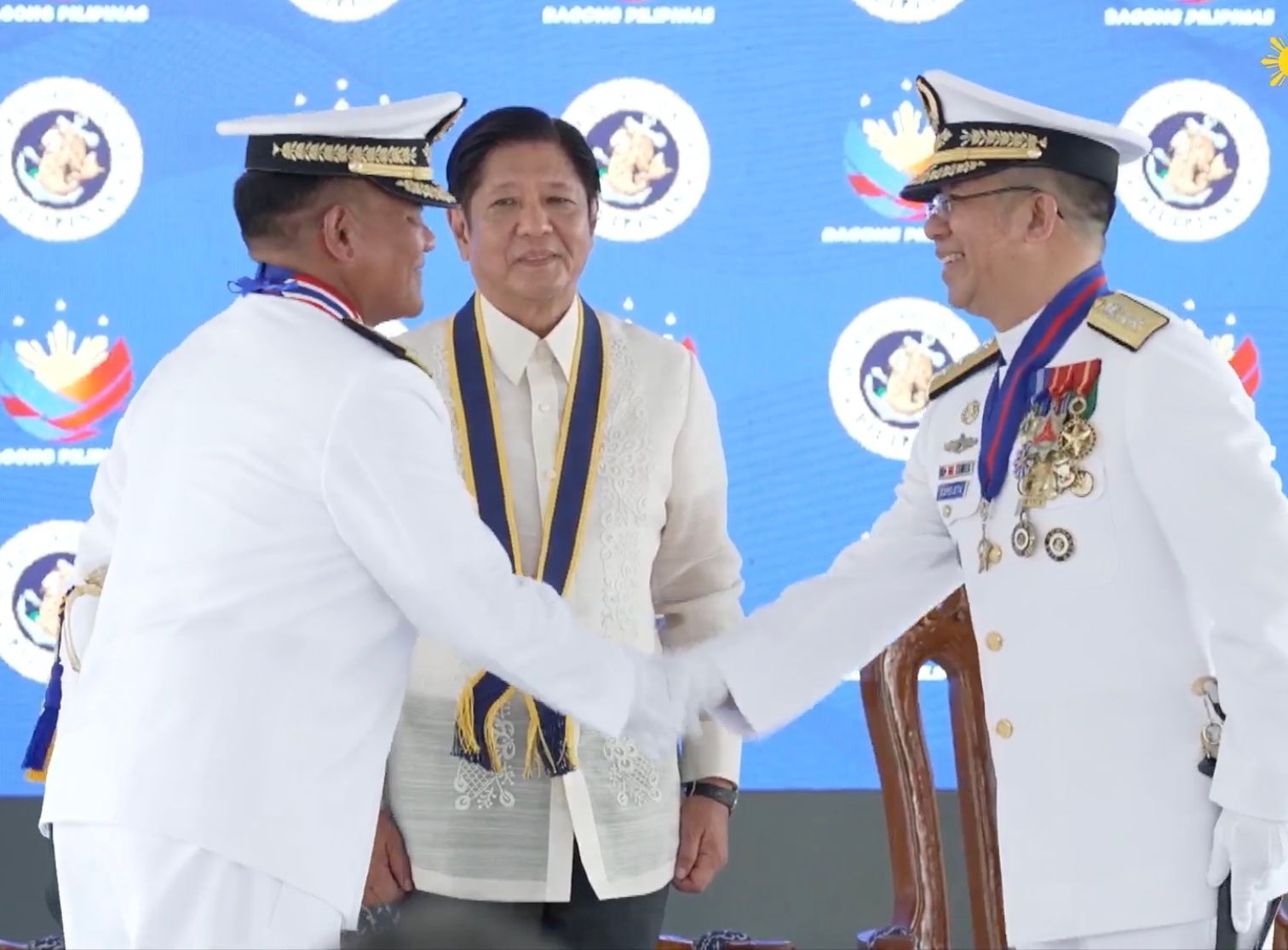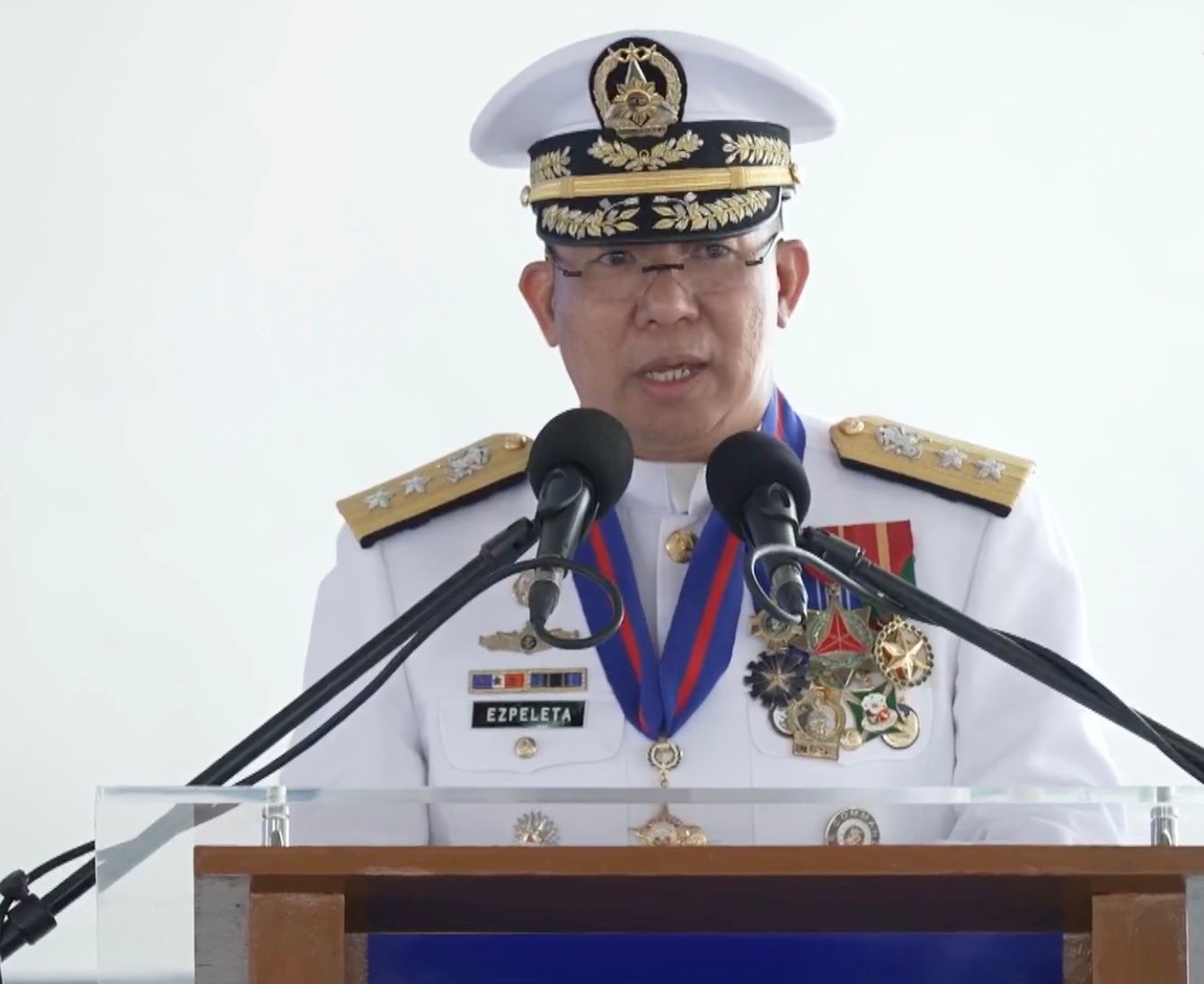Ezpeleta takes helm of PH Navy; vows to 'stay on course' amid 'complex' WPS situation

Rear Adm. Jose Ma. Ambrosio Ezpeleta committed to steer the Philippine Navy (PN) steadily amid the complex situation in the West Philippine Sea (WPS) as he was appointed as the 41st Flag Officer in Command of the Philippine Navy (FOIC, PN) on Friday, Nov. 15.
Ezpeleta took over from Vice Adm. Toribio Adaci Jr., who retired after a career of 39 years and seven months in the uniformed service, in a joint change of command and retirement ceremony presided by President Marcos Jr. at the PN headquarters Naval Station Jose Andrada in Manila.
In his speech, Ezpeleta acknowledged that the country’s oceans and seas are not merely vast expanses of water, rather, trade highways, food and livelihood sources, the largest ecosystem, and the front for current and developing geopolitical dynamics.
He said that the country is facing “challenges” that are “unlike any that we have seen in the past,” alluding to the tense maritime row with China in the WPS and emerging non-traditional security threats, which makes it hard for the navy to navigate in an “increasingly volatile, uncertain, complex, and ambiguous environment that is steadily transforming into a brittle, anxious, nonlinear, and incomprehensible one.”
“As such, navigating complex waters born out of the current security environment is no easy task. As the Flag Officer in Command, I commit to working diligently to perform my mandate, lead by example, and meet the growing expectations of our people from the Navy,” he said.
“At this critical juncture, the Philippine Navy shall stay on course and strive to deliver what is expected of us,” he added.
He said the 21st century is emerging as a “transformative maritime century” as it is primarily dictated by the ebbs and flows of the country’s oceans and seas where the PN is expected to play a crucial role to create credible deterrence “especially on attempts to subvert our maritime and arctic nations' sovereignty, sovereign rights, and territorial integrity.”
“Surely, there are rough seas that we may be sailing through in the future. When those moments come, it is our relentless commitment and our steadfast duty that will allow us to stay on course and remain full speed ahead, to act in concert, to defend our national interests, protect our people, and safeguard our waters,” Ezpeleta said.
Prior to his appointment as the new navy chief, Ezpeleta served as the vice commander of the PN since August 14, the number two man in the major service unit. He holds distinguished career in the navy, having served as the chief of naval staff and the commander of Naval Forces Southern Luzon.
Meanwhile, Adaci said that the PN has advanced its capabilities beyond routine patrols under his two-year stewardship since 2022.
“We are now a force capable of asserting our presence with greater strategic depth and vigilance,” said Adaci, a graduate of the Philippine Military Academy (PMA) “Makatao” Class of 1989.
Staying on course
Ezpeleta, on the other hand, stressed that staying on course is crucial as developments in the country’s oceans and seas “will likely shape the course of the future global order and the future of our maritime and archipelagic nation.”

The PMA “Sambisig” Class of 1991 product said the PN will continue to embrace and prepare for its increasing role in external defense operations, especially with the adoption of the Comprehensive Archipelagic Defense Concept (CADC), and in tandem with the Navy's Active Archipelagic Defense Strategy.
“Such a reorientation also requires us to intensify our maritime security operations by strengthening our presence in our operational areas. As such, we shall continue to enhance our support to the unified commands and push for the optimum deployment of our naval assets and personnel,” Ezpeleta said.
New maritime laws
Ezpeleta also hailed the recent enactment of the Maritime Zones Act and the Philippine Archipelagic Sea Lanes Act which “reinforce our nation's maritime entitlements and responsibility within our Maritime Zones under the United Nations Convention on the Law of the Sea (UNCLOS).”
“More importantly, it defines the scope of the Philippine Navy's areas of responsibility and allows us to protect, to project appropriate capabilities in our exclusive economic zones, which contribute to protecting sovereignty, promoting sustainable development, and securing future prosperity,” he noted.
Despite this, China continues to maintain its presence in some features of the WPS. Last month, the PN monitored 29 Chinese coast guard and navy vessels in certain contested features in the WPS.
Modernization, unconventional threats, alliances
To address this, Ezpeleta reiterated his commitment to support the ongoing modernization of the PN through the acquisition of new modern vessels and enhancement of naval bases and facilities, as well as the capacity building efforts for the sailors and marines.
He also recognized that the PN is facing “challenges that go beyond the scope of conventional warfare,” particularly asymmetric threats, cybersecurity threats, foreign-aligned influence, and continuous weaponization of information, which brings about fake news, misinformation, and disinformation.
“To navigate this landscape, we will continue developing Navy's asymmetric warfare capabilities, innovate our strategic communication, and enhance our cybersecurity capabilities,” he said.
The new navy chief also emphasized the importance of harnessing engagements with the PN’s naval counterparts from allied and friendly nations to build an effective workforce and strengthen the country’s rights in the South China Sea.
“As aligned with our independent foreign policy, the Philippines is able to diversify and enhance our relations with traditional and new found partners. This translates to the continuous harnessing of engagements with our naval counterparts, allowing us to use our assets, train interoperability, and put forward the importance of international law and the United Nations' arbitral ruling,” Ezpeleta said, referring to the 2016 landmark decision which invalidated China’s dash-line claims in the South China Sea.